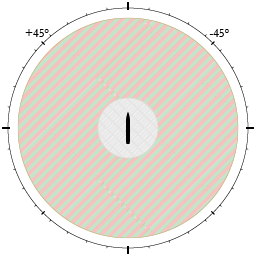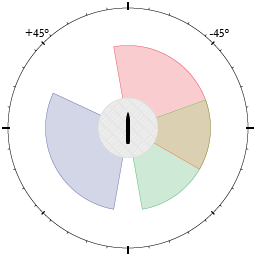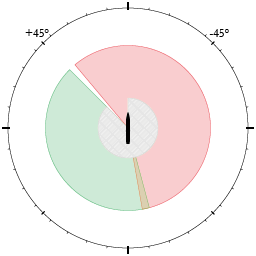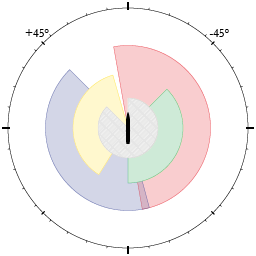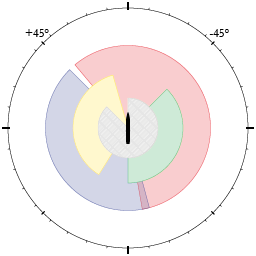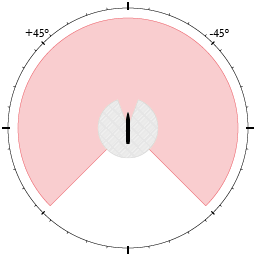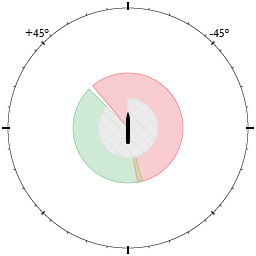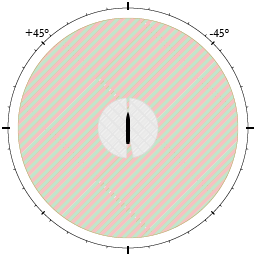DCS Reference/Ships/Western: Difference between revisions
mNo edit summary |
mNo edit summary |
||
| Line 11: | Line 11: | ||
=== Arleigh Burke-class Destroyer === | === Arleigh Burke-class Destroyer === | ||
[https://en.wikipedia.org/wiki/USS_Michael_Murphy DDG-112 Michael Murphy]<ref name="Wrong_DDG_Variant">Hull number 112 is supposed to be a single-CIWS variant, but the model in DCS features both a fore and an aft CIWS system.</ref> | {| class="wikitable" style="max-width: 1024px; width: 100%;" | ||
USS Arleigh Burke IIa (Supercarrier) | |+ [https://en.wikipedia.org/wiki/USS_Michael_Murphy DDG-112 Michael Murphy]<ref name="Wrong_DDG_Variant">Hull number 112 is supposed to be a single-CIWS variant, but the model in DCS features both a fore and an aft CIWS system.</ref> | ||
{{RWR|AE|Long}} | |- | ||
! Mission Editor Unit !! Function | |||
! colspan="2" | Stores | |||
! Range / Symbol | |||
|- | |||
| USS Arleigh Burke IIa (Supercarrier) | |||
| Guided-missile (AEGIS) destroyer | |||
| colspan="2" | 16+48× [[#RIM-66_Standard_Missile_2|RIM-66 Standard Missile 2]]<br/>2× 1550× 20mm [[#Phalanx_CIWS|Phalanx]]<br/>2× 230× 25mm Bushmaster<br/>1× 180× 127mm Mk45<br/>2× 16× BGM-109 Tomahawk | |||
| Detection: 0–80.1nm / 0–150km<br/>Detection alt.: 0–343,500ft / 0–104,700m<ref name="oldsensors"/><br/>{{RWR|AE|Long}}<br/>Engagement: 0–54.0nm / 0–100km<br/>Engagement alt.: 16.5–98,400ft / 5–30,000m | |||
|- | |||
! Hit points | |||
| 2,100 | |||
! Max speed | |||
| 15.6m/s (30.2kts, 56.0km/h) | |||
! Defensive arcs | |||
|- | |||
! Sensor limits<ref name="irreg_lockon"/> | |||
| colspan="3" | Surface radar: 360° horizontal × -5°–+10° vertical; 12s scan time.<br/>SS lock-on: 18.9nm / 35km. Notch: <15m/s (29kts, 54km/h) v<sub>rad</sub>.<br/>AA radar: 360° horizontal × -15°–+60° vertical.<br/>AA lock-on: 119.3nm / 221km. Notch: <15m/s (29kts, 54km/h) v<sub>rad</sub>.<br/>AEGIS trackers can guide 2 missiles per target at 9 targets at a time; lock-on time 2s.<br/>Target size limit: 0.1m².<ref name="missizes"/> | |||
| rowspan="2" style="width: 256px;" | [[File:DDG112Arc.png|right|frameless|Defensive systems main firing arcs.]] | |||
|- | |||
! Carrying capacity | |||
| colspan="3" | 1 defined helicopter parking spots.<br/>2 helicopter nominal capacity. | |||
|- | |||
! colspan="5" | Notes | |||
|- | |||
| colspan="5" | Acts as a warehouse to deliver stores to other units and to landed aircraft. Per the internal definitions, it cannot re-arm its own weapon stores once depleted. | |||
Is internally defined to allow attacks against targets up to 243nm / 450km away, presumably to allow for Tomahawk targeting. | |||
Requires the [[Supercarrier]] module to control and add to missions. | |||
|- | |||
! colspan="5" | Available to | |||
|- | |||
| colspan="5" | {{Flag|cblue|Combined Joint Task Force Blue}}{{Flag|cred|Combined Joint Task Force Red}}{{Flag|dpko|United Nations Peacekeepers}}{{Flag|us|USA|1991}}{{Flag|agg|USAF Aggressors}} | |||
|} | |||
=== Nimitz-class Carrier === | === Nimitz-class Carrier === | ||
| Line 42: | Line 77: | ||
|- | |- | ||
! Carrying capacity | ! Carrying capacity | ||
| colspan="3" | 13 defined aircraft parking spots.<br/>5 defined helicopter parking spots<br/>2+2 catapults (1+1 can be used safely in parallel).<br/>4 nominal spawn points.<br/>72 aircraft + 6 helicopter nominal capacity. | | colspan="3" | 13 defined aircraft parking spots.<br/>5 defined helicopter parking spots.<br/>2+2 catapults (1+1 can be used safely in parallel).<br/>4 nominal spawn points.<br/>72 aircraft + 6 helicopter nominal capacity. | ||
|- | |- | ||
! colspan="5" | Notes | ! colspan="5" | Notes | ||
|- | |- | ||
| colspan="5" | Acts as a warehouse to deliver stores to other units and to landed aircraft. Per the internal definitions, it cannot re-arm its own weapon stores once depleted. | | colspan="5" | Acts as a warehouse to deliver stores to other units and to landed aircraft. Per the internal definitions, it cannot re-arm its own weapon stores once depleted. | ||
Not compatible with the [[AV-8B_NA_Harrier|AV-8B NA Harrier]]. | |||
|- | |- | ||
! colspan="5" | Available to | ! colspan="5" | Available to | ||
| Line 74: | Line 111: | ||
|- | |- | ||
! Sensor limits | ! Sensor limits | ||
| colspan="3" | Surface radar: 360° horizontal × -5°–+10° vertical; 12s scan time.<br/>SS lock-on: 21.1nm / 39km. Notch: <15m/s (29kts, 54km/h) v<sub>rad</sub>.<br/>AA radar: 360° horizontal × -15°–+60° vertical; 1s scan.<br/>AA radar lock-on: 13.8nm / 25.5km. Notch: <10m/s (19kts, 36km/h) v<sub>rad</sub>.<br/>Mk95 trackers can engage 4 targets at a time; lock-on time 2.5s.<br/>Size limit: 0.1m².{{AGMSizeReference}} | | colspan="3" | Surface radar: 360° horizontal × -5°–+10° vertical; 12s scan time.<br/>SS lock-on: 21.1nm / 39km. Notch: <15m/s (29kts, 54km/h) v<sub>rad</sub>.<br/>AA radar: 360° horizontal × -15°–+60° vertical; 1s scan.<br/>AA radar lock-on: 13.8nm / 25.5km. Notch: <10m/s (19kts, 36km/h) v<sub>rad</sub>.<br/>Mk95 trackers can engage 4 targets at a time with 1 missile each; lock-on time 2.5s.<br/>Size limit: 0.1m².{{AGMSizeReference}} | ||
| rowspan="2" style="width: 256px;" | [[File:CVN74Arc.png|right|frameless|Defensive systems main firing arcs.]] | | rowspan="2" style="width: 256px;" | [[File:CVN74Arc.png|right|frameless|Defensive systems main firing arcs.]] | ||
|- | |- | ||
! Carrying capacity | ! Carrying capacity | ||
| colspan="3" | 19 defined aircraft parking spots.<br/>8 defined helicopter parking spots<br/>2+2 catapults ( | | colspan="3" | 19 defined aircraft parking spots.<br/>8 defined helicopter parking spots.<br/>2+2 catapults (2+2 can be used safely in parallel).<br/>4 nominal spawn points.<br/>72 aircraft + 6 helicopter nominal capacity. | ||
|- | |- | ||
! colspan="5" | Notes | ! colspan="5" | Notes | ||
| Line 85: | Line 122: | ||
The engagement limits only apply to the Mk95 trackers used to guide RIM-7 Sea Sparrows. | The engagement limits only apply to the Mk95 trackers used to guide RIM-7 Sea Sparrows. | ||
Not compatible with the [[AV-8B_NA_Harrier|AV-8B NA Harrier]]. | |||
|- | |- | ||
! colspan="5" | Available to | ! colspan="5" | Available to | ||
| Line 93: | Line 132: | ||
==== Theodore Roosevelt sub-class (Supercarrier) ==== | ==== Theodore Roosevelt sub-class (Supercarrier) ==== | ||
[https://en.wikipedia.org/wiki/USS_Theodore_Roosevelt_(CVN-71) CVN-71 Theodore Roosevelt] | {| class="wikitable" style="max-width: 1024px; width: 100%;" | ||
CVN-71 Theodore Roosevelt ( | |+ [https://en.wikipedia.org/wiki/USS_Theodore_Roosevelt_(CVN-71) CVN-71 Theodore Roosevelt], [https://en.wikipedia.org/wiki/USS_George_Washington_(CVN-73) CVN-73 George Washington], [https://en.wikipedia.org/wiki/USS_Harry_S._Truman CVN-75 Harry S. Truman] | ||
{{RWR|SS|Short}} | |- | ||
! Mission Editor Unit !! Function | |||
! colspan="2" | Stores | |||
! Range / Symbol | |||
|- | |||
| CVN-71 Theodore Roosevelt<br/>CVN-73 George Washington<br/>CVN-75 Harry S. Truman (Supercarrier) | |||
| Carrier | |||
| colspan="2" | 2× 8× [[#RIM-7_Sea_Sparrow|RIM-7 Sea Sparrow]]<br/>2× 21× [[#RIM-116_Rolling_Airframe_Missile|RIM-116 RAM]]<br/>2× 1550× 20mm [[#Phalanx_CIWS|Phalanx]] | |||
| Detection: 0–16.2nm / 0–30km<br/>Detection alt.: 0–87,200ft / 0–26,600m<br/>{{RWR|SS|Short}}<br/>Engagement: 0.2–16.2nm / 0.4–30km<br/>Engagement alt.: 15–49,200ft / 5–15,000m | |||
|- | |||
! Hit points | |||
| 7,300 | |||
! Max speed | |||
| 15.4m/s (29.9kts, 55.4km/h) | |||
! Defensive arcs<ref name="CVNArcBug">Currently, the tracking for the super carriers is incorrectly set, leaving a gap in roughly a 60%deg; cone in the front of the ship where it cannot use its forward Sea Sparrow battery.</ref> | |||
|- | |||
! Sensor limits | |||
| colspan="3" | Surface radar: 360° horizontal × -5°–+10° vertical; 12s scan time.<br/>SS lock-on: 21.1nm / 39km. Notch: <15m/s (29kts, 54km/h) v<sub>rad</sub>.<br/>AA radar: 360° horizontal × -15°–+60° vertical; 1s scan.<br/>AA radar lock-on: 13.8nm / 25.5km. Notch: <10m/s (19kts, 36km/h) v<sub>rad</sub>.<br/>Mk95 trackers can engage 3 targets at a time with 1 missile each; lock-on time 2.5s.<br/>Size limit: 0.1m².{{AGMSizeReference}} | |||
| rowspan="2" style="width: 256px;" | [[File:CVN71Arc.png|right|frameless|Defensive systems main firing arcs.]] | |||
|- | |||
! Carrying capacity | |||
| colspan="3" | 19 defined aircraft parking spots.<br/>8 defined helicopter parking spots.<br/>2+2 catapults (1+1 can be used safely in parallel).<br/>4 nominal spawn points.<br/>72 aircraft + 6 helicopter nominal capacity. | |||
|- | |||
! colspan="5" | Notes | |||
|- | |||
| colspan="5" | Acts as a warehouse to deliver stores to other units and to landed aircraft. Per the internal definitions, it cannot re-arm its own weapon stores once depleted. | |||
The engagement limits only apply to the Mk95 trackers used to guide RIM-7 Sea Sparrows. | |||
Not compatible with the [[AV-8B_NA_Harrier|AV-8B NA Harrier]]. | |||
Requires the [[Supercarrier]] module to control and add to missions. The different hulls only differ in terms of aesthetics and placement of on-board decorations. | |||
|- | |||
! colspan="5" | Available to | |||
|- | |||
| colspan="5" | {{Flag|cblue|Combined Joint Task Force Blue}}{{Flag|cred|Combined Joint Task Force Red}}{{Flag|dpko|United Nations Peacekeepers}}{{Flag|us|USA|1995}}{{Flag|agg|USAF Aggressors}} | |||
|} | |||
{| class="wikitable" style="max-width: 1024px; width: 100%;" | |||
|+ [https://en.wikipedia.org/wiki/USS_Abraham_Lincoln_(CVN-72) CVN-72 Abraham Lincoln] | |||
|- | |||
! Mission Editor Unit !! Function | |||
! colspan="2" | Stores | |||
! Range / Symbol | |||
|- | |||
| CVN-72 Abraham Lincoln (Supercarrier) | |||
| Carrier | |||
| colspan="2" | 2× 8× [[#RIM-7_Sea_Sparrow|RIM-7 Sea Sparrow]]<br/>2× 21× [[#RIM-116_Rolling_Airframe_Missile|RIM-116 RAM]]<br/>3× 1550× 20mm [[#Phalanx_CIWS|Phalanx]] | |||
| Detection: 0–16.2nm / 0–30km<br/>Detection alt.: 0–87,200ft / 0–26,600m<br/>{{RWR|SS|Short}}<br/>Engagement: 0.2–16.2nm / 0.4–30km<br/>Engagement alt.: 15–49,200ft / 5–15,000m | |||
|- | |||
! Hit points | |||
| 7,300 | |||
! Max speed | |||
| 15.4m/s (29.9kts, 55.4km/h) | |||
! Defensive arcs<ref name="CVNArcBug"/> | |||
|- | |||
! Sensor limits | |||
| colspan="3" | Surface radar: 360° horizontal × -5°–+10° vertical; 12s scan time.<br/>SS lock-on: 21.1nm / 39km. Notch: <15m/s (29kts, 54km/h) v<sub>rad</sub>.<br/>AA radar: 360° horizontal × -15°–+60° vertical; 1s scan.<br/>AA radar lock-on: 13.8nm / 25.5km. Notch: <10m/s (19kts, 36km/h) v<sub>rad</sub>.<br/>Mk95 trackers can engage 3 targets at a time with 1 missile each; lock-on time 2.5s.<br/>Size limit: 0.1m².{{AGMSizeReference}} | |||
| rowspan="2" style="width: 256px;" | [[File:CVN72Arc.png|right|frameless|Defensive systems main firing arcs.]] | |||
|- | |||
! Carrying capacity | |||
| colspan="3" | 19 defined aircraft parking spots.<br/>8 defined helicopter parking spots.<br/>2+2 catapults (1+1 can be used safely in parallel).<br/>4 nominal spawn points.<br/>72 aircraft + 6 helicopter nominal capacity. | |||
|- | |||
! colspan="5" | Notes | |||
|- | |||
| colspan="5" | Acts as a warehouse to deliver stores to other units and to landed aircraft. Per the internal definitions, it cannot re-arm its own weapon stores once depleted. | |||
The engagement limits only apply to the Mk95 trackers used to guide RIM-7 Sea Sparrows. | |||
[ | Not compatible with the [[AV-8B_NA_Harrier|AV-8B NA Harrier]]. | ||
[ | Requires the [[Supercarrier]] module to control and add to missions. Differs from the other Theodore Roosevelt supercarriers in having a third aft CIWS and a wider front Sea Sparrow engagement arc. | ||
|- | |||
{{ | ! colspan="5" | Available to | ||
|- | |||
| colspan="5" | {{Flag|cblue|Combined Joint Task Force Blue}}{{Flag|cred|Combined Joint Task Force Red}}{{Flag|dpko|United Nations Peacekeepers}}{{Flag|us|USA|1995}}{{Flag|agg|USAF Aggressors}} | |||
|} | |||
=== Oliver Hazard Perry-class Frigate === | === Oliver Hazard Perry-class Frigate === | ||
| Line 118: | Line 221: | ||
! Range / Symbol | ! Range / Symbol | ||
|- | |- | ||
| Oliver Hazard Perry class | | Oliver Hazard Perry class | ||
| Guided-missile frigate | | Guided-missile frigate | ||
| colspan="2" | 1× 24× [[#RIM-66_Standard_Missile_2|RIM-66 Standard Missile 2]]<br/>1× 1550× 20mm [[#Phalanx_CIWS|Phalanx]]<br/>4× 100× 12.7mm M2<br/>2× 230× 25mm Bushmaster<br/>1× 180× 76mm Mk75<br/>1× 16× RGM-84 Harpoon | | colspan="2" | 1× 24× [[#RIM-66_Standard_Missile_2|RIM-66 Standard Missile 2]]<br/>1× 1550× 20mm [[#Phalanx_CIWS|Phalanx]]<br/>4× 100× 12.7mm M2<br/>2× 230× 25mm Bushmaster<br/>1× 180× 76mm Mk75<br/>1× 16× RGM-84 Harpoon | ||
| Line 134: | Line 237: | ||
|- | |- | ||
! Carrying capacity | ! Carrying capacity | ||
| colspan="3" | 1 defined helicopter parking spots<br/>2 helicopter nominal capacity. | | colspan="3" | 1 defined helicopter parking spots.<br/>2 helicopter nominal capacity. | ||
|- | |- | ||
! colspan="5" | Notes | ! colspan="5" | Notes | ||
| Line 151: | Line 254: | ||
=== Tarawa-class Amphibious Assault Ship === | === Tarawa-class Amphibious Assault Ship === | ||
[https://en.wikipedia.org/wiki/USS_Tarawa_(LHA-1) LHA-1 Tarawa] | {| class="wikitable" style="max-width: 1024px; width: 100%;" | ||
|+ [https://en.wikipedia.org/wiki/USS_Tarawa_(LHA-1) LHA-1 Tarawa] | |||
{{RWR|40|Short}} | |- | ||
! Mission Editor Unit !! Function | |||
! colspan="2" | Stores | |||
! Range / Symbol | |||
|- | |||
| LHA-1 Tarawa | |||
| Amphibious Assault Ship | |||
| colspan="2" | 2× 21× [[#RIM-116_Rolling_Airframe_Missile|RIM-116 RAM]]<br/>2× 1550× 20mm [[#Phalanx_CIWS|Phalanx]] | |||
| Detection: 0–162.0nm / 0–300km<br/>Detection alt.: 0–85,800ft / 0–26,100m<ref name="oldsensors"/><br/>{{RWR|40|Short}}<br/>Engagement: 0.2–16.2nm / 0.4–30km<br/>Engagement alt.: 16.4–49,200ft / 5–15,000m | |||
|- | |||
! Hit points | |||
| 7,300 | |||
! Max speed | |||
| 15.4m/s (29.9kts, 55.4km/h) | |||
! Defensive arcs | |||
|- | |||
! Sensor limits | |||
| colspan="3" | Surface radar: 360° horizontal × -5°–+10° vertical; 12s scan time.<br/>SS lock-on: 21.1nm / 39km. Notch: <15m/s (29kts, 54km/h) v<sub>rad</sub>.<br/>AA Radar: 360° horizontal × -15°–+60° vertical; 1s scan.<br/>AA lock-on: 13.8nm / 25.5km. Notch: <10m/s (19kts, 36km/h) v<sub>rad</sub>.<br/>Mk95 trackers can engage 2 targets at a time with one missile each; lock-on time 2.5s.<br/>Target size limit: 0.1m².<ref name="missizes"/> | |||
| rowspan="2" style="width: 256px;" | [[File:LHA1Arc.png|right|frameless|Defensive systems main firing arcs.]] | |||
|- | |||
! Carrying capacity | |||
| colspan="3" | 8 defined aircraft parking spots.<br/>9 defined helicopter parking spots.<br/>4 nominal spawn points.<br/>40 aircraft + 36 helicopter nominal capacity. | |||
|- | |||
! colspan="5" | Notes | |||
|- | |||
| colspan="5" | Acts as a warehouse to deliver stores to other units and to landed aircraft. Per the internal definitions, it cannot re-arm its own weapon stores once depleted. | |||
Its detection and engagement range are defined to be an order of magnitude higher than any of its sensors and weapon systems could possibly reach or make use of, causing the threat circles in the mission editor to be ''massively and ridiculously'' over-exaggerated. The engagement ranges listed are what the on-board Mk95 tracking radar is actually capable of, which in turn exceeds what the actual weapon systems are capable of by a factor of ×2. | |||
|- | |||
! colspan="5" | Available to | |||
|- | |||
| colspan="5" | {{Flag|cblue|Combined Joint Task Force Blue}}{{Flag|cred|Combined Joint Task Force Red}}{{Flag|dpko|United Nations Peacekeepers}}{{Flag|us|USA|1976}}{{Flag|agg|USAF Aggressors}} | |||
|} | |||
=== Ticonderoga-class Cruiser === | === Ticonderoga-class Cruiser === | ||
| Line 164: | Line 299: | ||
! Range / Symbol | ! Range / Symbol | ||
|- | |- | ||
| Ticonderoga class | | Ticonderoga class | ||
| Guided-missile cruiser | | Guided-missile (AEGIS) cruiser | ||
| colspan="2" | 2× 45× [[#RIM-66_Standard_Missile_2|RIM-66 Standard Missile 2]]<br/>2× 1550× 20mm [[#Phalanx_CIWS|Phalanx]]<br/>3× 100× 12.7mm M2<br/>2× 230× 25mm Bushmaster<br/>2× 180× 127mm Mk45<br/>2× 4× RGM-84 Harpoon<br/>2× 16× BGM-109 Tomahawk | | colspan="2" | 2× 45× [[#RIM-66_Standard_Missile_2|RIM-66 Standard Missile 2]]<br/>2× 1550× 20mm [[#Phalanx_CIWS|Phalanx]]<br/>3× 100× 12.7mm M2<br/>2× 230× 25mm Bushmaster<br/>2× 180× 127mm Mk45<br/>2× 4× RGM-84 Harpoon<br/>2× 16× BGM-109 Tomahawk | ||
| Detection: 0–80.1nm / 0–150km<br/>Detection alt.: 0–343,500ft / 0–104,700m<ref name="oldsensors"/><br/>{{RWR|AE|Long}}<br/>Engagement: 0–54.0nm / 0–100km<br/>Engagement alt.: 16.5–98,400ft / 5–30,000m | | Detection: 0–80.1nm / 0–150km<br/>Detection alt.: 0–343,500ft / 0–104,700m<ref name="oldsensors"/><br/>{{RWR|AE|Long}}<br/>Engagement: 0–54.0nm / 0–100km<br/>Engagement alt.: 16.5–98,400ft / 5–30,000m | ||
| Line 180: | Line 315: | ||
|- | |- | ||
! Carrying capacity | ! Carrying capacity | ||
| colspan="3" | 1 defined helicopter parking spots<br/>2 helicopter nominal capacity. | | colspan="3" | 1 defined helicopter parking spots.<br/>2 helicopter nominal capacity. | ||
|- | |- | ||
! colspan="5" | Notes | ! colspan="5" | Notes | ||
Revision as of 05:29, 29 December 2020
Many carrier aircraft have somewhat contradictory definitions, or definitions of unclear value, as far as their carrying capacity. They may list only having 4 parking spots and a max number of aircraft or helicopters, in one sense, but then have coordinates set for over a dozen different parking spots on the deck. The blocks below distinguish between these two by calling them “nominal” and “defined” limits, where the nominal parking limit at most seems to correlate to how many different aircraft can be designated as “start on runway” in the mission editor.
The defensive arcs show the areas around the ship where specific defensive systems have full range of movement. This does not mean that areas that are not covered are safe — rather that the ship systems will be limited in their effectiveness because ship decks, conning towers, or bridges are in the way. However, given enough elevation, they can usually shoot over such obstructions, and only low-altitude skimming creates the coverage gaps demonstrated. In addition, depending on the guidance system of the weapon, they may be lofted above obstacles if the target is far enough away, which means that the “safe zone” only exists at low altitude and at close range.
Up to four range layers are shown in the arc sketches: close-range protection (from CIWS and simular systems); short-range protection, usually from IR-guided missiles; medium-range protection, usually from less advanced radar missiles; and long-range protection.
Ships
Arleigh Burke-class Destroyer
| Mission Editor Unit | Function | Stores | Range / Symbol | |
|---|---|---|---|---|
| USS Arleigh Burke IIa (Supercarrier) | Guided-missile (AEGIS) destroyer | 16+48× RIM-66 Standard Missile 2 2× 1550× 20mm Phalanx 2× 230× 25mm Bushmaster 1× 180× 127mm Mk45 2× 16× BGM-109 Tomahawk |
Detection: 0–80.1nm / 0–150km Detection alt.: 0–343,500ft / 0–104,700m[2] Engagement: 0–54.0nm / 0–100km Engagement alt.: 16.5–98,400ft / 5–30,000m | |
| Hit points | 2,100 | Max speed | 15.6m/s (30.2kts, 56.0km/h) | Defensive arcs |
| Sensor limits[3] | Surface radar: 360° horizontal × -5°–+10° vertical; 12s scan time. SS lock-on: 18.9nm / 35km. Notch: <15m/s (29kts, 54km/h) vrad. AA radar: 360° horizontal × -15°–+60° vertical. AA lock-on: 119.3nm / 221km. Notch: <15m/s (29kts, 54km/h) vrad. AEGIS trackers can guide 2 missiles per target at 9 targets at a time; lock-on time 2s. Target size limit: 0.1m².[4] |
|||
| Carrying capacity | 1 defined helicopter parking spots. 2 helicopter nominal capacity. | |||
| Notes | ||||
| Acts as a warehouse to deliver stores to other units and to landed aircraft. Per the internal definitions, it cannot re-arm its own weapon stores once depleted.
Is internally defined to allow attacks against targets up to 243nm / 450km away, presumably to allow for Tomahawk targeting. Requires the Supercarrier module to control and add to missions. | ||||
| Available to | ||||
Nimitz-class Carrier
Nimitz subclass
| Mission Editor Unit | Function | Stores | Range / Symbol | |
|---|---|---|---|---|
| CVN-70 Carl Vinson | Carrier | 3× 8× RIM-7 Sea Sparrow 4× 1550× 20mm Phalanx |
Detection: 0–16.2nm / 0–30km Detection alt.: 0–87,200ft / 0–26,600m[2] Engagement: 0–8.1nm / 0–15km Engagement alt.: 0–45,300ft / 0–13,800m | |
| Hit points | 7,300 | Max speed | 15.4m/s (29.9kts, 55.5km/h) | Defensive arcs |
| Sensor limits | Surface radar: 360° horizontal × -5°–+10° vertical; 12s scan time. SS lock-on: 21.1nm / 39km. Notch: <15m/s (29kts, 54km/h) vrad. AA Radar: 360° horizontal × -15°–+60° vertical; 1s scan. AA lock-on: 13.8nm / 25.5km. Notch: <10m/s (19kts, 36km/h) vrad. No target size limit is defined that would affect its ability to engage incoming air weapons. |
|||
| Carrying capacity | 13 defined aircraft parking spots. 5 defined helicopter parking spots. 2+2 catapults (1+1 can be used safely in parallel). 4 nominal spawn points. 72 aircraft + 6 helicopter nominal capacity. | |||
| Notes | ||||
| Acts as a warehouse to deliver stores to other units and to landed aircraft. Per the internal definitions, it cannot re-arm its own weapon stores once depleted.
Not compatible with the AV-8B NA Harrier. | ||||
| Available to | ||||
Theodore Roosevelt sub-class (Basic)
| Mission Editor Unit | Function | Stores | Range / Symbol | |
|---|---|---|---|---|
| CVN-74 John C. Stennis | Carrier | 2× 8× RIM-7 Sea Sparrow 3× 1550× 20mm Phalanx |
Detection: 0–16.2nm / 0–30km Detection alt.: 0–87,200ft / 0–26,600m Engagement: 0.2–8.1nm / 0.4–15km Engagement alt.: 15–49,200ft / 5–15,000m | |
| Hit points | 7,300 | Max speed | 15.4m/s (29.9kts, 55.4km/h) | Defensive arcs |
| Sensor limits | Surface radar: 360° horizontal × -5°–+10° vertical; 12s scan time. SS lock-on: 21.1nm / 39km. Notch: <15m/s (29kts, 54km/h) vrad. AA radar: 360° horizontal × -15°–+60° vertical; 1s scan. AA radar lock-on: 13.8nm / 25.5km. Notch: <10m/s (19kts, 36km/h) vrad. Mk95 trackers can engage 4 targets at a time with 1 missile each; lock-on time 2.5s. Size limit: 0.1m².[4] |
|||
| Carrying capacity | 19 defined aircraft parking spots. 8 defined helicopter parking spots. 2+2 catapults (2+2 can be used safely in parallel). 4 nominal spawn points. 72 aircraft + 6 helicopter nominal capacity. | |||
| Notes | ||||
| Acts as a warehouse to deliver stores to other units and to landed aircraft. Per the internal definitions, it cannot re-arm its own weapon stores once depleted.
The engagement limits only apply to the Mk95 trackers used to guide RIM-7 Sea Sparrows. Not compatible with the AV-8B NA Harrier. | ||||
| Available to | ||||
Theodore Roosevelt sub-class (Supercarrier)
| Mission Editor Unit | Function | Stores | Range / Symbol | |
|---|---|---|---|---|
| CVN-71 Theodore Roosevelt CVN-73 George Washington CVN-75 Harry S. Truman (Supercarrier) |
Carrier | 2× 8× RIM-7 Sea Sparrow 2× 21× RIM-116 RAM 2× 1550× 20mm Phalanx |
Detection: 0–16.2nm / 0–30km Detection alt.: 0–87,200ft / 0–26,600m Engagement: 0.2–16.2nm / 0.4–30km Engagement alt.: 15–49,200ft / 5–15,000m | |
| Hit points | 7,300 | Max speed | 15.4m/s (29.9kts, 55.4km/h) | Defensive arcs[5] |
| Sensor limits | Surface radar: 360° horizontal × -5°–+10° vertical; 12s scan time. SS lock-on: 21.1nm / 39km. Notch: <15m/s (29kts, 54km/h) vrad. AA radar: 360° horizontal × -15°–+60° vertical; 1s scan. AA radar lock-on: 13.8nm / 25.5km. Notch: <10m/s (19kts, 36km/h) vrad. Mk95 trackers can engage 3 targets at a time with 1 missile each; lock-on time 2.5s. Size limit: 0.1m².[4] |
|||
| Carrying capacity | 19 defined aircraft parking spots. 8 defined helicopter parking spots. 2+2 catapults (1+1 can be used safely in parallel). 4 nominal spawn points. 72 aircraft + 6 helicopter nominal capacity. | |||
| Notes | ||||
| Acts as a warehouse to deliver stores to other units and to landed aircraft. Per the internal definitions, it cannot re-arm its own weapon stores once depleted.
The engagement limits only apply to the Mk95 trackers used to guide RIM-7 Sea Sparrows. Not compatible with the AV-8B NA Harrier. Requires the Supercarrier module to control and add to missions. The different hulls only differ in terms of aesthetics and placement of on-board decorations. | ||||
| Available to | ||||
| Mission Editor Unit | Function | Stores | Range / Symbol | |
|---|---|---|---|---|
| CVN-72 Abraham Lincoln (Supercarrier) | Carrier | 2× 8× RIM-7 Sea Sparrow 2× 21× RIM-116 RAM 3× 1550× 20mm Phalanx |
Detection: 0–16.2nm / 0–30km Detection alt.: 0–87,200ft / 0–26,600m Engagement: 0.2–16.2nm / 0.4–30km Engagement alt.: 15–49,200ft / 5–15,000m | |
| Hit points | 7,300 | Max speed | 15.4m/s (29.9kts, 55.4km/h) | Defensive arcs[5] |
| Sensor limits | Surface radar: 360° horizontal × -5°–+10° vertical; 12s scan time. SS lock-on: 21.1nm / 39km. Notch: <15m/s (29kts, 54km/h) vrad. AA radar: 360° horizontal × -15°–+60° vertical; 1s scan. AA radar lock-on: 13.8nm / 25.5km. Notch: <10m/s (19kts, 36km/h) vrad. Mk95 trackers can engage 3 targets at a time with 1 missile each; lock-on time 2.5s. Size limit: 0.1m².[4] |
|||
| Carrying capacity | 19 defined aircraft parking spots. 8 defined helicopter parking spots. 2+2 catapults (1+1 can be used safely in parallel). 4 nominal spawn points. 72 aircraft + 6 helicopter nominal capacity. | |||
| Notes | ||||
| Acts as a warehouse to deliver stores to other units and to landed aircraft. Per the internal definitions, it cannot re-arm its own weapon stores once depleted.
The engagement limits only apply to the Mk95 trackers used to guide RIM-7 Sea Sparrows. Not compatible with the AV-8B NA Harrier. Requires the Supercarrier module to control and add to missions. Differs from the other Theodore Roosevelt supercarriers in having a third aft CIWS and a wider front Sea Sparrow engagement arc. | ||||
| Available to | ||||
Oliver Hazard Perry-class Frigate
| Mission Editor Unit | Function | Stores | Range / Symbol | |
|---|---|---|---|---|
| Oliver Hazard Perry class | Guided-missile frigate | 1× 24× RIM-66 Standard Missile 2 1× 1550× 20mm Phalanx 4× 100× 12.7mm M2 2× 230× 25mm Bushmaster 1× 180× 76mm Mk75 1× 16× RGM-84 Harpoon |
Detection: 0–80.1nm / 0–150km Detection alt.: 0–343,500ft / 0–104,700m[2] Engagement: 0–54.0nm / 0–100km Engagement alt.: 0–229,000ft / 0–69,800m | |
| Hit points | 2,300 | Max speed | 14.9m/s (29.0kts, 53.6km/h) | Defensive arcs |
| Sensor limits[3] | Surface radar: 360° horizontal × -5°–+10° vertical; 12s scan time. SS lock-on: 18.2nm / 33.6km. Notch: <15m/s (29kts, 54km/h) vrad. AA radar: 360° horizontal × -15°–+60° vertical. AA lock-on: 119.3nm / 221km. Notch: <15m/s (29kts, 54km/h) vrad. Mk92 tracker can engage 1 targets at a time; lock-on time 10s. No target size limit is defined that would affect its ability to engage incoming air weapons. |
|||
| Carrying capacity | 1 defined helicopter parking spots. 2 helicopter nominal capacity. | |||
| Notes | ||||
| Acts as a warehouse to deliver stores to other units and to landed aircraft. Per the internal definitions, it cannot re-arm its own weapon stores once depleted.
The Mk13 launch rail has a nominal readying time of 12s between missiles, but this is almost always swallowed up by the locking time and guidance of previous missiles, unless the enemy target is at very close range (in which case missiles are often not used at all). Is internally defined to allow attacks against targets up to 65.8nm / 120km away, presumably to allow for Harpoon targeting. | ||||
| Available to | ||||
Tarawa-class Amphibious Assault Ship
| Mission Editor Unit | Function | Stores | Range / Symbol | |
|---|---|---|---|---|
| LHA-1 Tarawa | Amphibious Assault Ship | 2× 21× RIM-116 RAM 2× 1550× 20mm Phalanx |
Detection: 0–162.0nm / 0–300km Detection alt.: 0–85,800ft / 0–26,100m[2] Engagement: 0.2–16.2nm / 0.4–30km Engagement alt.: 16.4–49,200ft / 5–15,000m | |
| Hit points | 7,300 | Max speed | 15.4m/s (29.9kts, 55.4km/h) | Defensive arcs |
| Sensor limits | Surface radar: 360° horizontal × -5°–+10° vertical; 12s scan time. SS lock-on: 21.1nm / 39km. Notch: <15m/s (29kts, 54km/h) vrad. AA Radar: 360° horizontal × -15°–+60° vertical; 1s scan. AA lock-on: 13.8nm / 25.5km. Notch: <10m/s (19kts, 36km/h) vrad. Mk95 trackers can engage 2 targets at a time with one missile each; lock-on time 2.5s. Target size limit: 0.1m².[4] |
|||
| Carrying capacity | 8 defined aircraft parking spots. 9 defined helicopter parking spots. 4 nominal spawn points. 40 aircraft + 36 helicopter nominal capacity. | |||
| Notes | ||||
| Acts as a warehouse to deliver stores to other units and to landed aircraft. Per the internal definitions, it cannot re-arm its own weapon stores once depleted.
Its detection and engagement range are defined to be an order of magnitude higher than any of its sensors and weapon systems could possibly reach or make use of, causing the threat circles in the mission editor to be massively and ridiculously over-exaggerated. The engagement ranges listed are what the on-board Mk95 tracking radar is actually capable of, which in turn exceeds what the actual weapon systems are capable of by a factor of ×2. | ||||
| Available to | ||||
Ticonderoga-class Cruiser
| Mission Editor Unit | Function | Stores | Range / Symbol | |
|---|---|---|---|---|
| Ticonderoga class | Guided-missile (AEGIS) cruiser | 2× 45× RIM-66 Standard Missile 2 2× 1550× 20mm Phalanx 3× 100× 12.7mm M2 2× 230× 25mm Bushmaster 2× 180× 127mm Mk45 2× 4× RGM-84 Harpoon 2× 16× BGM-109 Tomahawk |
Detection: 0–80.1nm / 0–150km Detection alt.: 0–343,500ft / 0–104,700m[2] Engagement: 0–54.0nm / 0–100km Engagement alt.: 16.5–98,400ft / 5–30,000m | |
| Hit points | 2,700 | Max speed | 15.4m/s (29.9kts, 55.4km/h) | Defensive arcs |
| Sensor limits[3] | Surface radar: 360° horizontal × -5°–+10° vertical; 12s scan time. SS lock-on: 18.9nm / 35km. Notch: <15m/s (29kts, 54km/h) vrad. AA radar: 360° horizontal × -15°–+60° vertical. AA lock-on: 119.3nm / 221km. Notch: <15m/s (29kts, 54km/h) vrad. AEGIS trackers can guide 2 missiles per target at 9 targets at a time; lock-on time 2s. Target size limit: 0.1m².[4] |
|||
| Carrying capacity | 1 defined helicopter parking spots. 2 helicopter nominal capacity. | |||
| Notes | ||||
| Acts as a warehouse to deliver stores to other units and to landed aircraft. Per the internal definitions, it cannot re-arm its own weapon stores once depleted.
Is internally defined to allow attacks against targets up to 243nm / 450km away, presumably to allow for Harpoon and Tomahawk targeting. | ||||
| Available to | ||||
Systems
Phalanx CIWS
RIM-7 Sea Sparrow
RIM-66 Standard Missile 2
RIM-116 Rolling Airframe Missile
Notes
- ↑ Hull number 112 is supposed to be a single-CIWS variant, but the model in DCS features both a fore and an aft CIWS system.
- ↑ 2.0 2.1 2.2 2.3 2.4 This unit uses an antiquated and simplified sensor definition based on angles to define its search altitude, as opposed to more moden explicit limits.
- ↑ 3.0 3.1 3.2 According to the measuring distance and lock-on distance coefficient in the data files, this system can actually detect and lock targets beyond its stated in-effect detection range. This is because it uses stats of a land-based system that could conceivably have distributed and data-linked detectors that would necessitate such capabilities in its simulation.
- ↑ 4.0 4.1 4.2 4.3 4.4 4.5 Compare, effective target sizes:
- Small: Vikhr: 0.012m² · AGM-114: 0.015m² · AGM-122: 0.03m² · BGM-71 0.033m²
- Medium: AGM-88 / C-701 / LD-10: 0.05m² · Kh-23 / Kh-25 / Kh-66: 0.06m² · AGM-154 0.05–0.062m³ · AGM-65 / Rb-75: 0.063m² · LS-6: 0.07m² · C-802 / AGM-45: 0.09m²
- Large: GB-6 / Kh-35: 0.1m² · Kh-58 / Rb-04 / Rb-05 / Rb-15 / Sea Eagle: 0.12m² · AGM-84: 0.08–0.17m² · AGM-86 / Kh-65: 0.17m² · Kh-29: 0.18m² · Kh-59: 0.2m² · Kh-31: 0.3m² · BK-90: 0.4m²
- OMFG: ADM-141: 0.9–1.2m² · Kh-22: 1.82m² ·
- ↑ 5.0 5.1 Currently, the tracking for the super carriers is incorrectly set, leaving a gap in roughly a 60%deg; cone in the front of the ship where it cannot use its forward Sea Sparrow battery.



